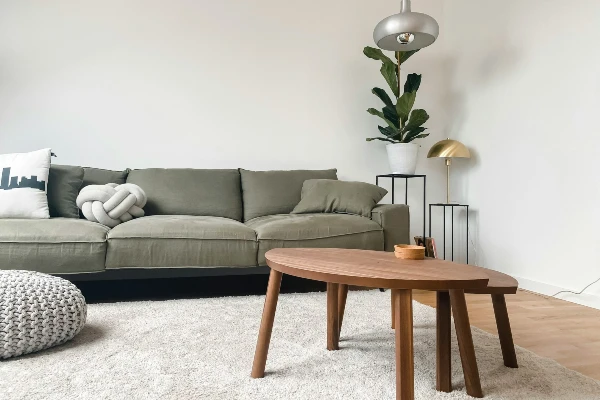Disclosure: This post may contain affiliate links, meaning we get a commission if you decide to make a purchase through our links, at no cost to you. Please read our disclosure for more info.
When you buy a fine area rug, you want to make sure it is well-cared for and protected. There are several steps you can take to do so. First, rotate your rug every three to six months. Rotation is important to prevent mildew and mold. Also, keep your rug free of dust and debris to prevent mites and other insects from settling in.
In This Post:
Rotate Your Rug Every 3-6 Months
Rotating your fine area rug every few months is a good idea, not only to prevent uneven wear, but also to ensure it remains clean. Rotation can also help prevent the pile from flattening and discoloration caused by foot traffic. Likewise, rotating rugs will protect them from uneven wear caused by the weight of furniture. And for the ease of rotating you should buy medium to small size rugs. You can buy rugs to the size of standard size comforters.
To maintain the luster of your fine area rug, clean it regularly and rotate it every 3-6 months. This is a simple task, and it will help prevent fading. It will also keep your rug from smelling and feeling dirty. Moreover, it will help reduce the appearance of dirt and mildew, which can be harmful for your fine area rug.
Avoid Store-Bought Carpet Shampoos
If you want to maintain the look and feel of your fine area rug for a long time, you should avoid store-bought carpet shampoos. These products can damage your rug’s colors and may even discolor it. If you’re unsure of what kind of shampoo to use, you can always test a small amount on a small part of your rug. Wait for one to two hours, then inspect it for any signs of discoloration. If you’re still not satisfied, you should purchase a different type of product.
When choosing a carpet shampoo, make sure you use one that’s biodegradable. Some carpet shampoos use chemical cleaners that can harm your rug. For example, some are made of petroleum-based products, which can be hazardous to your fine area rug. Moreover, the chemical residue left behind by conventional carpet shampoos is not biodegradable. Instead, you should use a shampoo that is certified by the Leaping Bunny. This certification ensures that the product is free of cruelty.
Avoid Vacuuming With A Beater Bar
When vacuuming a fine area rug, it is best to turn off the beater bar. This will avoid damaging the fine fringes. While this function is helpful for deep cleaning cut-pile carpeting, it can loosen the fibers in looped or Berber-style rugs. In addition, errant strands can become tangled in the rotating brush, unraveling the fibers and creating a run.
Vacuuming an area rug is important for removing dust, dirt, and debris. However, vacuuming too vigorously will damage the fibers. To vacuum an area rug with delicate fibers, take several passes. Vacuum in the direction of the pile. Avoid beating the rug with the beater bar, which can damage the backing and tangle the fibers. Also, when vacuuming a rug with a thin pile, use a soft vacuum cleaner with low suction. It is best to vacuum your area rug at least twice a month, preferably every two weeks.
Place An Underlay Under Your Rug
If you have fine runner rugs for your home, it is essential to place an underlay beneath it to protect it. This is because underlaying your rug will help to keep it level, protect it from damage, and prevent it from slipping. In addition, the underlay will keep noise from being transmitted through the floor to the rug. A good underlay will also make your rug feel softer. There are several types of underlays on the market.
There are two main types of underlays for area rugs. One is for large rugs, while the other is for smaller ones. The former is ideal for high traffic areas, while the latter is designed for lower-traffic areas. Both of these types are made of durable materials, but they are also available in fixed sizes that are compatible with LVT flooring.
Prevent Creases On Your Rug
There are a number of ways to prevent creases on a fine area rug. First of all, the best way is to avoid putting the rug under a heavy object, such as a sofa or twin and twin XL size bed. A simple solution for this problem is to place ice cubes or melted ice cubes on the dented area overnight. This will relax the fibers and eliminate wrinkles. If ice cubes do not remove creases, you can use a spray bottle filled with water and use that to spray the affected area.
Another solution to prevent creases is to rotate your area rug frequently. This will evenly spread the wear and tear on the rug. Sometimes, an area rug will not lay flat after cleaning, but with these tips, you can easily prevent them and keep your rug looking as good as new.
Insecticides Are Only Necessary For Fine Area Rugs
If you suspect your fine area rug has been infested with a moth infestation, you should seek help from a pest control specialist. A professional will provide you with a variety of solutions, including moth balls that can be placed inside the rug and sealed inside a heavy plastic bag. You may also be able to treat the rug yourself using a solution of vinegar and water.
The first step in preventing bug infestation is to vacuum and dust the rugs regularly. Insects will be attracted to loose carpet fibers and will eat them. Often, this damage is only visible on the back of a rug, but can easily spread from one area to another. A thorough cleaning will prolong the life of a fine area rug by keeping bugs away.
Conclusion
It is imperative to protect your fine area rugs from the elements to maintain their beauty and value. Luckily, there are several simple ways to care for your rugs. You can take steps to prevent the most common stains and damages. The first step is to understand what causes these problems. One of the most common culprits is moth larvae. These tiny worms are about 3/8 inches long and can cause serious damage to your fine area rugs. Moth larvae can remain in an area rug for up to 30 months. They leave behind a grainy sand-like excrement.




